Last Updated on January 1, 2023 by asoulwindow
Table of Contents
About Sarnath
Sarnath is a world-famous Buddhist destination in Varanasi in Uttar Pradesh. Sarnath is an international destination where several ancient monuments are venerated even today.
Some of the major attractions and places of interest near Sarnath temple or Sarnath Mandir include monuments such as Dhamek Stupa, Chaukhandi stupa, Sarnath deer park, seated Buddha statue, Ashokan pillar, Sarnath Museum, Mulagandhakuti Vihara, Dharmarajika Stupa and the sacred Bodhi tree.
Why is Sarnath Famous?
Sarnath is world-famous because this is where Gautama Buddha delivered the first major sermon to his first five disciples after gaining enlightenment. Sarnath was also where the original Sangha or the community of monks was formed!
The deer park of Sarnath is as famous as its ancient Stupas and Jain temples. While locals come here for picnic in winters, the Buddhists visit Sarnath for pilgrimage. Not to forget the history buffs who are attracted by the ancient ruins of Sarnath! The peaceful and green environs of Sarnath are a departure from the lively Ghats of Varanasi.
Sarnath is also popular because of so many places you can see here such as the archaeological museum, various Buddha temples, deer parks, Buddhist monasteries, ancient stupas, old ruins, and remnants of grand Jain temples. You will also see a rare sangam or confluence of various faiths such as Hinduism, Jainism and Buddhism in Sarnath.
Sarnath is one of the 4 most important Buddhist pilgrimage destinations. The others are Lumbini in Nepal where Gautam Buddha was born, Bodh Gaya in Bihar, India where he attained enlightenment and Kushinagar in Uttar Pradesh in North India which marked his death.

First Sermon by Gautam Buddha
Bhagwan Gautam Buddha delivered his first sermon in Varanasi is a known fact. It was in Sarnath where he famously turned the wheel of the world, better known as the Maha Dharma Chakra Parivartan. The ruins of monuments I saw in Sarnath were constructed to commemorate the event eons ago by Mauryan Emperor- Ashoka the great!
Sarnath by night
You must visit Sarnath during night to see it bathed in various beautiful lights!
Sarnath nomenclature
The word Sarnath is a derivative of Saranganath. The literal meaning of Saranganath is the ‘Lord of deer’. The ancient name of Sarnath was Rishipattana. The word Rishipattana means ‘Where the Rishi arrived’
In old times, Sarnath was also known as Mrigadava or the deer park and Isipatana which means the place where holy men fell to Earth!
Who destroyed Sarnath?
Much of Sarnath was destroyed by the Islamic invaders from Turkey.
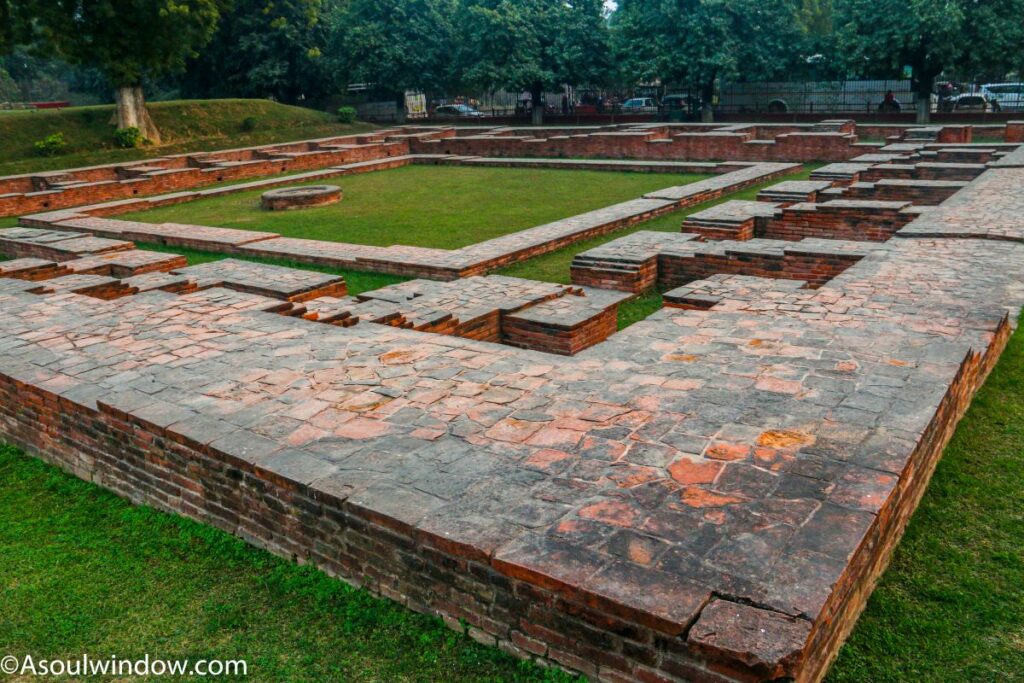
My Sarnath Connection
I feel lucky that I was born in the holy city of Varanasi, also known by its ancient name Kashi or Benaras aka Banaras. It is indeed a blessing to take birth in the city which is also the abode of the supreme Hindu God Shiv Bhagwan. My parents had left Varanasi soon after I was born to other cities of Uttar Pradesh such as Kanpur, Prayagraj, Lucknow and Ghaziabad!
I have a strong connection with Varanasi, which is why ever since childhood I keep returning to this ancient city.
I have childhood memories of lingering around the pious ghats of Banaras and going agape mouthed at the ruins of Sarnath. I remember, during childhood, while strolling around the ruin complex of Sarnath, I came across an underground structure.
Fearing it will swallow me, I stayed away. That was when I was not much of a traveler and used to wear my pants till my navel! Not to forget the awkward moustache and a mop of hair that almost hid my eyes!
This comprehensive guide on Sarnath is written based upon my many visits to Sarnath and Varanasi. Being a local native person of the amazing Indian state Uttar Pradesh, I have a unique perspective which many other writers do not!
Sarangnath Temple, Sarnath
You will be surprised to learn that the Buddhist destination Sarnath is christened after the Hindu word Sarangnath which means Lord of the deer. I had no idea about it myself until I paid a visit to Sarnath!
When you are in Sarnath, then you must visit the holy Sarangnath Temple, devoted to Shiv Bhagwan. In fact, this is the only Hindu temple in North India, where you will see two Shivlings within the same Garbhagriha of the temple. There is an interesting legend behind this in my detailed blog on the temples of Varanasi.
Hindu devotees visit Sarangnath temple in the months of Savan in large numbers in the hope of getting rid of their skin diseases. It is located just 1 kilometer away from the ruins of Sarnath.
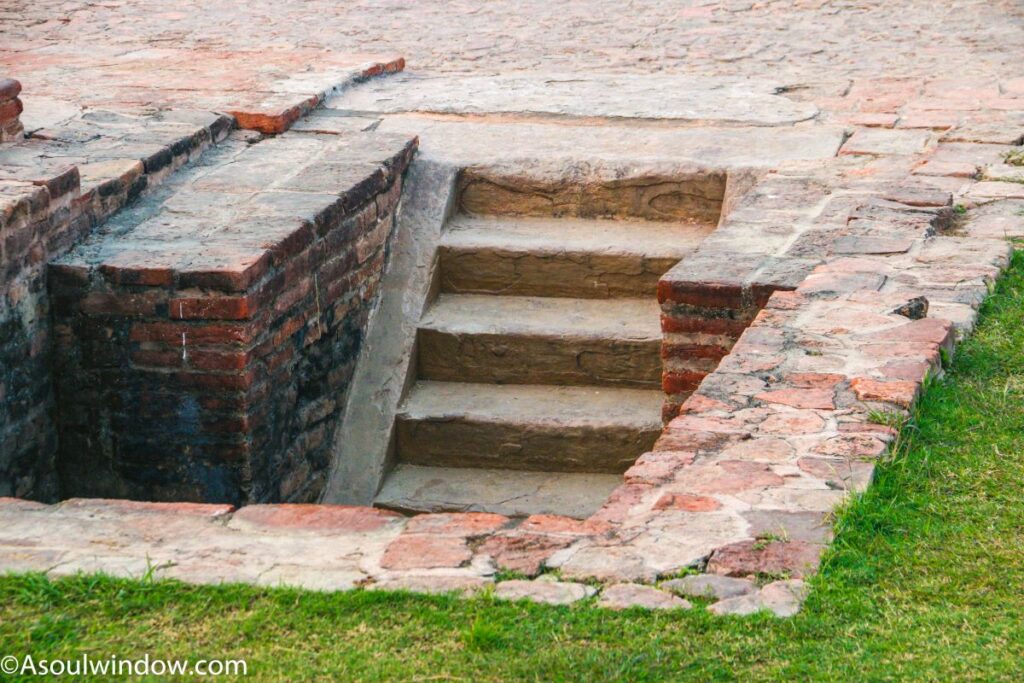
Sarnath- International Destination
Some of the best places to see in India are located in Uttar Pradesh. Sarnath is a truly Indian destination that attracts Buddhist pilgrims from not just India but all over the world.
Some of the greatest religions of the world such as Sanatan Dharm aka Hinduism, Jainism, Sikhism and Buddhism are born in India. India, one of the most powerful nations of the world, is a cradle of civilizations since times immemorial.
Since centuries the spiritual and material wealth of India has attracted seekers, travelers, explorers, merchants, spiritual gurus and even Islamic invaders and European invaders. People visit you only when you have something to give. Sarnath is no exception!
I saw many Buddhist monks beautifying the green gardens of Sarnath with their robes, some in orange, some red and some even yellow and maroon. Buddhist Pilgrims pay a visit to Sarnath from different countries from South Asia and South East Asia such as Sri Lanka, Myanmar, Thailand, Korea, Taiwan, Japan and even the predominantly Malaysia and Indonesia.
I saw Buddhist monks silently praying, chanting, meditating or just spending some quiet time on the premises of Sarnath ruin complex. Some even circumambulate around the sacred Dhamek Stupa in the clock wise direction and touch the Stupa.
I joined them, engulfed in a space brimming with positive energy and piety. The positive spiritual energy is to be seen to be believed. Some even offer rectangular gold foils.
On the lawns, I saw a group of Buddhist monks meditating together while sitting on the grass. I observed some monks reading the first sermon of Buddha Bhagwan as their handheld incense sticks perfumed the Sarnath complex.
It is very common to see busloads of international Buddhist tourists accompanied with a guide explaining about the history of Sarnath on a mike in English and other international languages. For many devout Buddhists, visiting Sarnath is a spiritual milestone, waiting to be accomplished. Much like what Kailash Mansaorovar Yatra is for Hindus and Bon people.
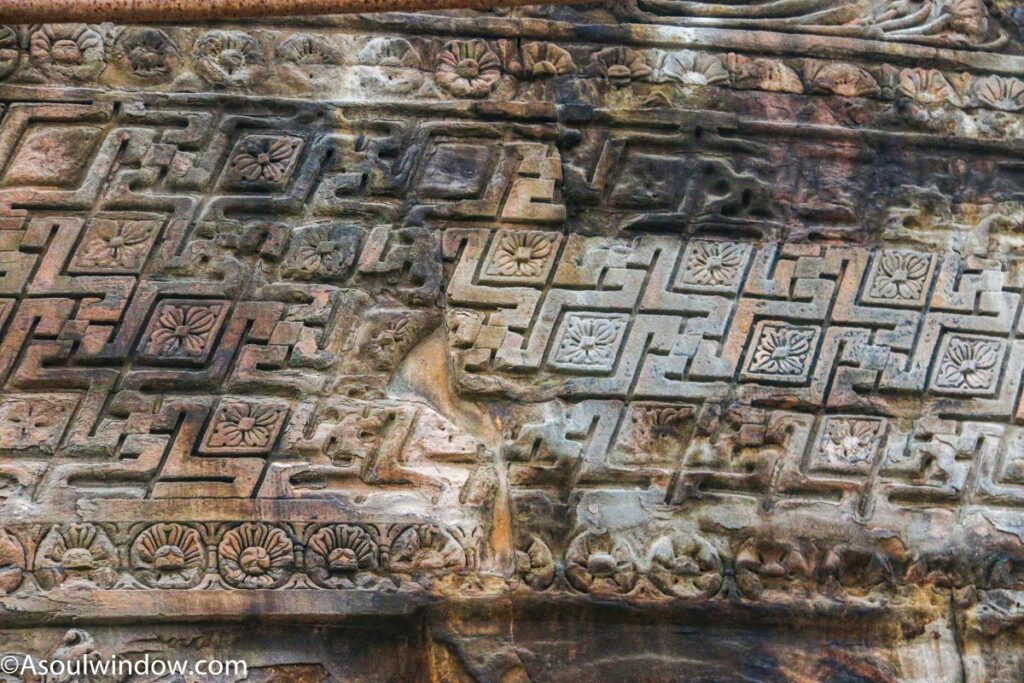
The International Buddha Circuit
The region of North India is famous for its International Buddha Circuit as it is where major events from the life and times of Gautam Buddha Bhagwan unfolded. Most of these places are located near to each other.
No wonder, the famous Buddha Circuit train run by IRCTC includes Sarnath and Varanasi as a major stop along with other Buddhist destinations such as Bodhgaya, Nalanda and Rajgir in Bihar, Kushinagar and Shravasti in Uttar Pradesh and Lumbini in Nepal.
This affordable train ride helps international tourists to see the best of Buddhist destinations in India within a week without worrying about hotels, local transport and food. The Buddhist train starts from New Delhi.
The 7 nights 8 days long Buddha luxury train run by Indian Railways is loved by international tourists. Much like the luxury train of South India known as the Golden Chariot. I have a separate blog on Golden Chariot. Do read it.
Soul Window Observations
My home state Uttar Pradesh is a tourist magnet. Most of the tourists that come to India, do visit Uttar Pradesh. I am proud to belong to Uttar Pradesh as this Indian state has the most famous destinations of India. Not only is it home to India’s only 7 wonders of the world, Taj mahal but is also the venue of the Hindu festival Mahakumbh Mela, largest congregation of humans on Earth.
Uttar Pradesh is also where holy Indian rivers such as Ganga Maiyya, Yamuna ji and the mythical Saraswati River flow. At their confluence in Prayagraj, they become one. I did see their colors change during the boat ride I took on one of the days of Mahakumbh.
Some of the top places to see in Uttar Pradesh are Varanasi, Kumbh Mela and Sangam in Prayagraj, Taj Mahal and Fatehpur Sikri in Agra, Deogarh, Kushinagar, Shravasti, Mathura and Vrindavan near New Delhi. These mostly spiritual tourist places are so famous that every year lakhs and crores of people pay a visit here, adding to the local tourism economy.
Uttar Pradesh indeed needs no promotion. It is unnecessarily defamed by media houses, perhaps jealous of its prosperity and high spiritual ground!
History of Buddhist Stupas
In pre-Buddhist times, stupas were tumuli where ascetics and saints were buried in a seated posture. This is what Buddhist Stupas evolved from. It was a common Indian feature. The later hemispherical Buddhist Stupas were fashioned after the pre-Buddhist burial mounds of India.
The Buddhist commemorative monument were being built to house the sacred relics of Buddha and others such as his disciples. These ancient Stupas were circular mounds encircled by huge stone pieces.
After the Parinirvana of Bhagwan Gautam Buddha, his mortal remains were cremated. The holy ashes of Buddha were divided and buried in 8 mounds. The contents of other two mounds included the embers and urn.
Historians have not been able to trace these early 10 stupas and therefore not much can be said about them. It is believed that the Dhamek Stupa of Sarnath and Sanchi Stupa of Madhya Pradesh were built on the sites of earlier mounds.
The great emperor Ashoka dug up relics of Buddha, divided them into 84,000 portions and built Stupas over them throughout the land he ruled from. The Stupas were very sacred and destruction of the stupas was seen as a serious crime, much like the murder of someone.
Ashoka was one of the greatest emperors of India from the Mauryan Empire. The fierce warrior had a change of heart once he understood the futility of war after winning one. This is why he is one of my most favorite characters from ancient Indian history. He became a passionate convert to Buddhism and played an active role in promoting it throughout Asia.
Buddhist relics and Stupas in other nations
The relics of Gautama Buddha were further distributed in various parts of the world such as Sri Lanka, Bangladesh, Bhutan, China, Afghanistan, Indonesia, Japan, Russia, Korea, Malaysia, Singapore, Mongolia, Myanmar, Nepal, Pakistan, Persia, Tibet, Vietnam, Laos, Cambodia and Thailand.
Soul Window Facts
Did you know that one of tallest Buddhist stupas was built in Pakistan near the present Peshawar during the Kushan era? It is known as Kanishka Stupa. The precious Buddhist relics found here were shifted to the U Khanti Dazaung or hall at Mandalay Hill, in Mandalay, Burma in South Asia.
The shapes of Stupas differ in other nations such as the multi storied Japanese, Korean and Chinese Pagodas, “heart of garbha” or the bell-shaped dagaba of ancient Ceylon aka Sri Lanka, the multi terraced Buddhist temple of Borobudur in Java in Indonesia and another version in Tibet.
The Buddhist devotees circumambulate around these sacred Stupas in a clockwise manner. It is known as kora.
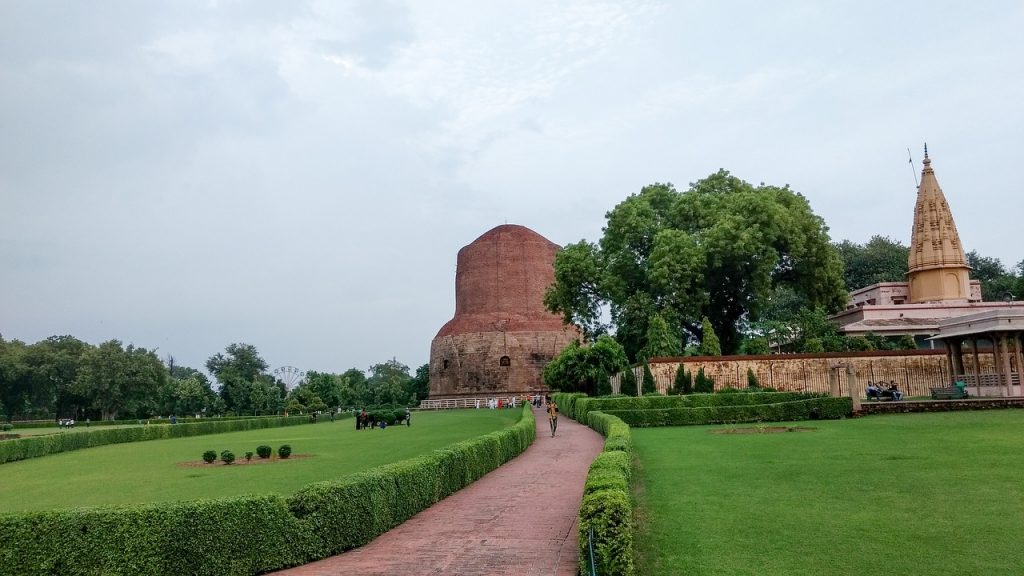
Places to see in Sarnath
Below are the major attractions of Sarnath
Dhamek Stupa of Sarnath
This lofty stupa known as the Dhamek Stupa is the top place to visit in Varanasi. Some of the best-preserved ancient Buddhist Stupas I saw was in Sanchi in Madhya Pradesh in central India. Dhamek Stupa was initially known as the Dharma Chakra Stupa.
History of Dhamek Stupa, Sarnath
Dhamek Stupa was commissioned by the great Mauryan emperor Ashoka in 3rd century B.C.E. in the year 249 B.C.E. to mark his visit to the deer park. Later additions were done in the year 500 C.E. which replaced the structure built by Ashoka the great. Emperor Ashoka used to build Stupas to enshrine precious relics of Bhagwan Buddha and his disciples such as calcinated bones.
The archeologists had discovered an ancient inscription from the site which states that the world famous Dhamek Stupa was originally names as Dharma Chakra Stupa. This inscription can be traced back to 1026 C.E.
Dhamek Stupa is also spelt as Dhamekha or Dhamekh. The literal meaning of Dhamek Stupa is the Stupa of the reign of Dharma.
As per Xuanzang, the Chinese Buddhist monk there were around 1,500 priests who stayed here and the main stupa measured a whooping 300 feet or 91 meters in height. Xuanzang visited Sarnath in the year 640 C.E.
I was impressed to see the towering stupa which measures 93.5 feet or 28.5 meters diameter at base and 140 feet or 42.60 meter in height, including the foundation. Without foundation, the height of Dhamek Stupa is 110 feet or 33.36 meters. The circular stone drum measures 37 feet or 11.20 meters in height from the ground level.
There are total of 8 niches in Dhamek Stupa which are located in 8 different directions. It is concluded by the historians that these niches must have contained the sacred images of Bhagwan Buddha.
Running right below them are various carvings on stone which include the sacred symbol Swastika, floral designs, leaves, human figures, birds, geometric patterns and even ancient inscriptions in the Brāhmī script. The delicate floral carvings are from the Gupta era. It is possible that statues of Lord Buddha were present in the arched niches halfway on the stupa.
Constructed entirely out of bricks and stone, the ancient Dhamek Stupa still stands tall as a testimony to the rich cultural landscape of ancient India. The last royal endowment at the site can be traced back to 12th century C.E. Despite enlarging the Dhamek Stupa, 6 times over, the upper part of it remains unfinished.
What makes Dhamek Stupa significant is the fact that this is where Gautam Buddha gave his first sermon to his 5 disciples led by Kaundinya after he attained enlightenment in what is now a Buddhist pilgrimage town called Bodhgaya in present Bihar in North India.
This is also where Buddha Bhagwan revealed the famous eightfold path to Nirvana and enlightenment.
Dhamek Stupa, the cylindrical tower, thus can be known as the foundation of modern Buddhism. The Four Noble truths which Buddha taught here are still revered.
What also makes Dhamek Stupa significant is the fact that this is where Gautam Buddha brought forth the Dhammachakkapavattana Sutta as well as the Anattalakkhana Sutta. The colossal structure of Dhamek Stupa stands out and is the tallest edifice in Sarnath. Needless to say, it can be seen from a distance.
It is said that Alexander Cunningham, the European founder of Archaeological Survey of India aka ASI in his search for the relic casket in Dhamek Stupa, bored a vertical shaft which went all the way from its center to the foundation of the ancient Stupa at a depth of 91.4 centimeters.
He found a slab with an inscription in the ancient Brahmi language prevalent during old days. The inscription which can be traced back to 6th-7th century said, “Ye Dharma Hetu Prabhavna Hetu”.
Similar inscriptions have been found in other Buddhist sites such as Sherghatti near Bodhgaya and Tirhut, both in Bihar, Prayagraj in Uttar Pradesh and Sanchi Stupa in Madhya Pradesh.
Alexander also discovered a stupa which was built with Mauryan bricks.
Dharmarajika Stupa Sarnath
Dharmarajika Stupa has been identified as the stupa which was commissioned by Ashoka the great in 3rd century B.C.E. to enshrine the relics of Buddha Bhagwan. As it happened under his reign, King Ashoka had opened seven original stupas which housed the relics of Buddha except the Ramgram Stupa in Nepal, which was guarded by Serpent King Nagas who did not allow him to open it.
He removed the relics of Buddha and after redistributing them, enshrined them in Sarnath as well as many other places in India and other Asian nations. Dharmarajika Stupa happens to be one of those Stupas. His goal was to create thousands of such Stupas around Asia.
Emperor Ashoka had played a major role in spreading Buddhism in not only across India but also many international destinations such as Sri Lanka.
Dharmarajika Stupa was a small Stupa, which originally measured only 44 feet or 13.49 meters in diameter. Later additions were made to it between 3rd century BCE to 9th or 10th century C.E. (the (early medieval era) before it was finally destroyed.
Over six different phases, the Dharmarajika Stupa was enlarged by adding structures which increased its height. Many other monasteries were renovated and built in the vicinity in this period.
This helped build a circumambulatory path, designed like a medhi (as seen in Sanchi Stupa). There were monolithic staircases located at 4 different cardinal directions which helped Buddhist pilgrims to climb on the stupa in old days. The remains of the pradakshina patha or the ambulatory floor made of bricks prove the same.
This walking path was a first of its kind anywhere in India. Instead of being supported by a railing, a solid brick wall had surrounded the walking passage. That makes Dharmarajika Stupa an aberration. I myself have visited many Buddhist stupas, new and old and all of them have a railing around the circumambulatory path and not an enclosed wall.
Unfortunately, thanks to the ravages of times, not much remains to be seen at the Dharmarajika Stupa barring a 3-foot circular platform. The ‘anda’ or the dome and the path surrounding it is nowhere to be seen. I leave it to my imagination on what this ancient Stupa must have looked like!
It is said that Jagat Singh, the Diwan of King of Banaras, Chet Singh, destroyed the Dharmarajika Stupa in the year 1794 C.E. with the aim of exploiting the material of the edifice. He had discovered a circular stone box which housed a relic casket of green marble.
It is claimed that the stone box belonged to the times of Ashoka and was located in the center of the dome. Unfortunately, the casket was immersed unceremoniously in the Ganga River. However, you can still see the box in the Indian Museum in Kolkata in West Bengal near North East India.
Valuable ancient idols such as that of seated Buddha in Dharma Chakra Pravartana Mudra from the glorious Gupta era as well as huge Bodhisattva built in red sand stone from the Kushan era have been unearthed from the periphery of the Dharmarajika Stupa, located near Dhamek Stupa. Railings from the Sunga era have also been excavated in Sarnath.
This clearly indicates that the first addition to the Stupa built by Ashoka was done during the Kushan era or early Gupta era.
Interestingly Dharmarajika Stupa is located towards north of entrance of Sarnath complex, very close to where Gautam Buddha gave his 1st sermon!
Chaukhandi Stupa Sarnath
I had my first view of Chaukhandi Stupa from the Garden of Spiritual Wisdom. As soon as I entered the quaint premises of Sarnath, the first structure I noticed was the Chaukhandi Stupa which was built in the 5th century.
Significance
What makes the site of Chaukhandi Stupa significant is the fact that this is where Bhagwan Gautam Buddha was reunited with his 5 disciples aka Panchavargiya Bhikshus, after being separated from them in Rajgir in Bihar. I had visited Rajgir, Nalanda and Vaishali on a single trip to Bihar.
It is believed that to commemorate the same, Chaukhandi Stupa was constructed as a terraced temple between 4th and 6th century C.E. during the Gupta period. I felt sad to see that not much remains except for a maze of bricks on a high earthen mound.
Buddhist Pilgrims perform kora or parikrama around the Chaukhandi Stupa as they consider it as a blessing. I saw many Buddhist monks clad in colourful robes and chanting Buddham Sharnam Gacchami.
Islamic Invasion on Chaukhandi Stupa, Sarnath
I lingered around the ancient Chaukhandi Stupa for a while, closely studying its rectangular plinth, before I noticed the difference in architecture within the same edifice. An ugly looking octagonal medieval structure built above the stupa didn’t actually blend with the architecture of the original stupa.
Turned out, it was a later addition to the original structure. That makes in an unusual Buddhist Stupa of all the stupas I have been to till date!
What’s more? This odd-looking octagonal Mughal tower was constructed by Govardhan, son of Akbar’s finance minister Raja Todar Mal, in the year 1589 C.E. in memory of his father’s visit to Sarnath. Humayun was the father of Akbar.
The Islamic invaders were habitual offenders who looted and mindlessly robbed Indian and Buddhist temples of yore. Whether it is Srirangam temple in Tamilnadu or Martand Temple in Kashmir, Dwarka in Gujarat or Sri Jagannath Mandir of Puri in Odisha, these holy places have repeatedly attacked by marauding fanatic Islamists of medieval India.
Devout Buddhists perform a kora or parikrama around Chaukhandi Stupa as well. Many images and statues from the Gupta era have been excavated at the Chaukhandi Stupa.
Garden of Spiritual Wisdom
It is a must-see place in Sarnath Varanasi.
Shreyanshnath Jain Mandir
The 19th century Shreyanshnath Jain Mandir is a must visit place when in Sarnath. Constructed in the year 1824 C.E., this Jain Temple is a fine specimen of ancient art and architecture dominant in this region.
Devoted to Lord Shreyanshnath, the 11th tirthankara, it reminded me of Jain temples of Pavagarh is faraway Gujarat in West India. The Jain community believes that the site of Shreyanshnath Jain Mandir is where Lord Shreyanshnath was born!
I feel that the most noticeable features of this ancient Jain temple are the frescos that depict the life and times of Bhagwan Mahavir in beautiful details.
Sri Digamber Jain Temple
Located near the Dhamek Stupa, the Sri Digamber Jain Temple is revered by the Jain community. You can get acquainted with Digambara monasticism which is a branch of Jain Dharma.
Deer Park of Sarnath
One of the most famous places to see in Sarnath in Varanasi is the deer park. It is believed by the Buddhists that this is where Lord Gautam Buddha taught the sacred Dhammachakkapavattana Sutta as well as the Anattalakkhana Sutta to his 5 disciples following which they propagated his teachings in other parts of India and elsewhere.
We know from the numerous ancient sources that Buddha’s 1st sermon happened in Mriga-dayaa-vanam, the literal meaning of which is a ‘forest of deer’ or the ‘sanctuary of deer’. Mriga means deer and vanam means forest in Sanskrit.
It is said that in those times, a huge population of spotted deer inhabited this area. The deer would give the enlightened Lord Buddha company as he taught the laws of Dharma for the posterity. The land here was gifted by the King of Varanasi as a goodwill gesture.
Even to this date, we can see many spotted deer in the deer park of Sarnath.
Excavated Archaeological Site
You can visit the ancient ruins in the Excavated Archaeological Site to get a hang of the history of Sarnath.
Precious relics from the past such as Ashokan pillars dot the land scape of this al fresco heritage exhibition. Unfortunately, only the base of Ashokan pillars remain now. Giving them company are the remains of 4 ancient monasteries, decaying monuments and other such old structures which belong to the great Mauryan Empire. The monasteries were built between 3rd century C.E. to 12th century C.E.
Entry Fee to Dhamek Stupa is INR 20 for Indians and INR 200 for foreigners. This combined entry fee includes visit to the Dhamek Stupa, the ruin complex of Sarnath as well as the Sarnath Archeological Museum. These are maintained by the ASI aka Archeological Survey of India.
Soul Window Thoughts
I often hear foreigners complaining of the difference in price tickets for Indians and foreigners. I think the extra ticket price for entry in Indian monuments for foreigners visiting India is justified because everyone pays huge amounts of money for just using toilets in Europe and forced to take flights and private cabs in U.S.A. known for its poor infrastructure of public transport.
Ashoka Pillar at Sarnath
The good news is that the Ashoka Pillar in Sarnath aka Aśoka Column is still located in its place and not looted and caged in a clinical British Museum, which is nothing but a collection of stolen historical objects from around the world.
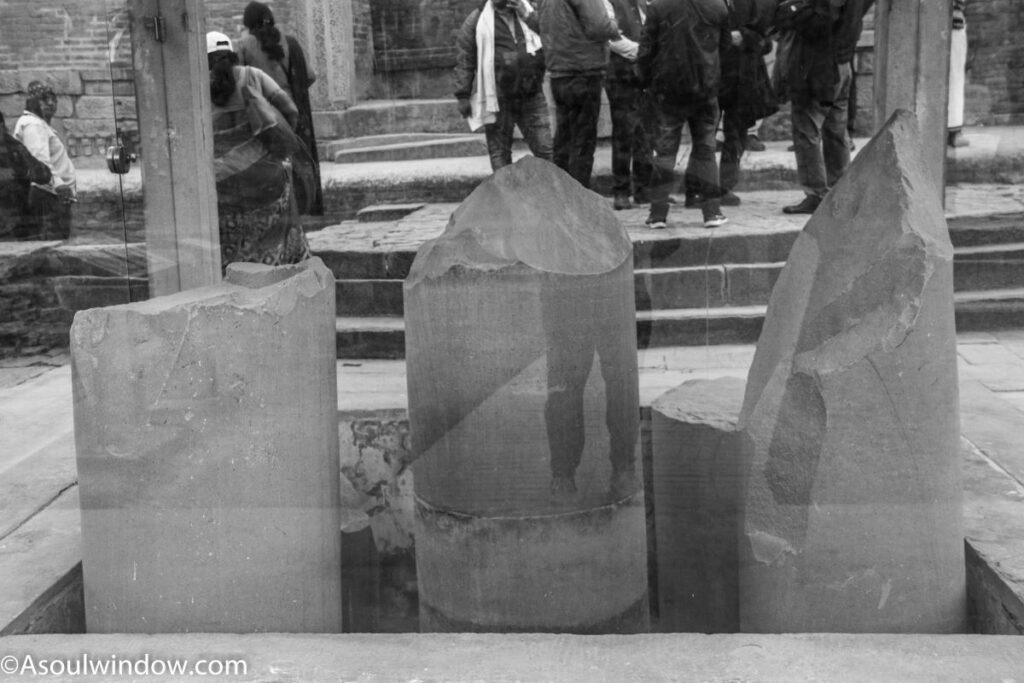
The famed Ashokan Pillar was carved out of a block of polished sandstone. It is the only surviving Ashokan pillar in the world, bearing the famous edicts of Ashoka, which is in such good condition.
Emblem
The world-famous Lion Capital of Ashoka which rested atop the Ashokan Pillar depicts four Asiatic Lions, facing 4 directions. It is the national emblem of India. It was commissioned by Ashoka the great in 250 B.C.E when the Mauryan Empire was at its peak! The capital rests atop a bell-shaped lotus flower. Lotus is also the national flower of India.
The National emblem is also used by Indian Government officials along with the tagline ‘Satyameva Jayate’ which means ‘Truth Alone Wins’. You can see it on Indian stamps and Indian passports as well. As an Indian, I have grown up seeing the capital from Ashokan Pillar around me.
Animals on Ashokan Pillar
Apart from the large structure of 4 Asian lions, other animals found on the Ashokan Pillar are an elephant, a galloping horse, a bull and a lion again. A spoked chariot wheel sits between each animal.
Ashok Chakra
The wheel located below the 4 lions can be seen in the national flag of India. Now you can understand why Sarnath is one of the most important destinations in India. The Ashoka wheel is also known as Ashok Chakra, Dharmachakra or the Wheel of Dharma. The wheel has 24 spokes.
Ashoka Pillar at Sanchi Stupa and Vaishali
I saw a similar damaged Ashokan Pillar lying carelessly in the lawns of Sanchi Stupa in Madhya Pradesh. I could easily touch it as there was no barricading around the precious pillar. I was impressed to see that even after so many centuries, the Ashokan Pillar was shiny and smooth as glass. You can read my full travel guide on Sanchi Stupa here.
You can see the capital of Ashoka pillar of Sanchi at the Sanchi Archaeological Museum.
You can obviously not touch the Ashokan Pillar at Sarnath in Varanasi. Ashoka Pillar of Sarnath with engraved edict is located near the Dhamek Stupa.
I saw a similar Ashokan Pillar in Vaishali in Bihar as well. You can read my comprehensive travel blog on Vaishali here.
Ashoka Pillar in Chiang Mai, Thailand
Did you know that King Mangrai from Lanna Dynasty of Thailand had built a replica of the Ashokan Pillar at Sarnath in the 13th century C.E. The Thai Ashokan Pillar is located in Wat Umong in the hilly Chiang Mai in North Thailand.
Wat Umong was built in the year 1297 C.E.
The Thai Ashokan pillar features 4 lions and a wheel at the base, much like its counterpart at Vaishali and Sarnath. A wheel also accompanies the lions at the top. It is surrounded by dense canopy of trees.
Sarnath Archaeological Museum
Step into this time warp as you transport yourself to a bygone era. If you want to understand how advanced and great the Indian civilization was then a visit to the Archaeological Museum is a must!Rare artifacts from 3rd century B.C.E. to 12 centuries C.E. are displayed in pretty good condition here.
Despite its small size, this museum if one of the most important museums of India as it houses some very precious artifacts excavated from the region in and around Sarnath.
The iconic Ashokan Lion in polished sandstone, which is often also seen on Indian currency notes and coins can also be seen here.
The Ashokan Lion is the national emblem of India. The other notable sculptures and displays of Archaeological Museum of Sarnath include statues of Bodhisattva, the Goddess Tara and other carved Buddhist artifacts. I had bought the mask of Green Tara Goddess from Thamel, in Kathmandu in Nepal. You can buy from Sarnath as well.
Soul Window Travel Tips
The Archaeological Museum of Sarnath is airconditioned and remains closed on Friday. There are many galleries located in the museum, all of which you must visit. You need to submit the cellphone, DSLR camera, point and shoot cameras as photography and videography is strictly prohibited inside the Sarnath Archaeological Museum.

Mulagandha Kuti Vihar
It is a beautiful temple which has immense importance to Buddhists. It is said that Lord Buddha used to meditate at this spot.
A massive bell vies for my attention as I enter the premises of the Mulagandha Kuti Vihar. I leaned it was gifted by the Japanese. Mulagandha Kuti Vihar was constructed in the year 1931 by the founder of Mahabodhi society, Angarika Dharmapala.
Historians claim that the new temple was built on a site of an earlier Sarnath temple from the great Gupta period. I could not help but think that the modern replica of the old temple, must not be a patch on the original.
You can see the famous golden statue of Gautam Buddha in the Mulagandha Kuti Vihar. The posture of statueshows Lord Buddhadelivering his first sermon to the 5 ascetics.Buddha is also said to have spent his first rainy season here.
The platform on whichthe statue is placed hidesancient relics of Gautam Buddha.Once in a year on the auspicious occasion of Buddha Poornima, the prized relics are taken out of the sacred chamber.
It reminded me of my visit to the Sri Dalada Maligawa or the Temple of the Sacred Tooth Relic, located in Kandy in Sri Lanka. It is a major Buddhist Temple in South Asia which houses the precious tooth relic of Gautam Buddha.
The work of Japanese artist Kosetsu Nosu include the well-made frescos on the inner walls of the Mulagandha Kuti Vihar. You can see the entire life of Gautam Buddha depicted on these frescos, right from his birth to the attainment of Mahaparinirvana.
Some of the notable paintings located here depict scenes such as the legend of Angulimala, the distractions of Mara, mourning the Death of Gautam Buddha, Gautam Buddha leaving home as his wife sleeps etc.
Lord Buddha attained Mahaparinirvana is what is now an important Buddhist pilgrimage site known as Kushinagar. It is located in my home state Uttar Pradesh near Lucknow in North India. Another Buddhist site Shravasti is also located in the same region near the Indo Nepal border.
It may be closed during lunch hours. In that case you can visit the nearby Digambar Jain Temple.
Bodhi Tree of Sarnath
I have visited the predominantly Buddhist Sri Lanka many times so I was curious when I noticed a connection in Sarnath. Apparently, a branch of the original Bodhi tree of Anuradhapura in Sri Lanka has been planted in the Mulagandha Kuti Vihar inSarnath.
The Bodhi tree of Anuradhapura is also known as Jaya Sri Maha Bodhi or simply as thesacred Bo tree.Did you know that the Bodhi tree of Anuradhapura is a southern branch from the original Sri Mahabodhi Temple in Bodh Gaya aka Buddha Gaya in Bihar in North India?
Needless to say, the Bodhi Tree of Sarnath is one of the oldest surviving religious trees of the world. A massive bell with inscriptions is another attraction here. It is one of the best places to visit in Sarnath.
I noticed a Buddhist pilgrim picking up a fallen leaf from the Bodhi tree and quietly kept it in her bag. No one found it odd or batted an eyelid. Pilgrims do it as a blessing. I myself picked a fallen leaf and inserted it in my fat Lonely Planet India Guide Book as I sat next to the original Bodhi Tree in Bodhgaya.
Tibetan Temple of Sarnath
Two colorful statue of lion guards, common in Tibetan places, welcomed me as I entered the premises of the Tibetan Temple of Sarnath.
The alluring idol of Shakyamuni Buddha is the main highlight of the Tibetan Temple of Sarnath. The huge Thangka paintings depicting Buddhist themes are also a must see when visiting the Tibetan Temple of Sarnath. And before you leave, do not forget to move the Wheel of Dhamma.
During my visit to Tibet, I understood about their culture closely. A poignant chorten located within the Tibetan monastery compound was built in order to commemorate the supreme sacrifice which the people of Tibet did by losing their lives during the long struggle for the freedom of Tibet.
I saw similar glimpse of Tibetan life near Gunehar in Bir Billing and Mcleodganj in Himachal Pradesh, near Ravang La in Sikkim and even Coorg in Karnataka in South India.
Soul Window observations
I have visited Tibet during the once in a lifetime Kailash Mansarovar Yatra and can vouch that the architecture of Tibetan Temple of Sarnath matches with the architecture of Buddhist monasteries I saw in Tibet or closer home in Mechuka, Dirang, Tawang and Bomdila in Arunachal Pradesh. The Buddhist monasteries I saw in Namchi, Pelling, Gangtok etc in Sikkim were also similar. Not to forget Ladakh in North India and Bhutan.
Thai Temple of Sarnath
How can a temple from Thailand be left behind in an Indian Buddhist pilgrimage site? The famous Hinayana Buddha Temple is located within the well-manicured sprawling lawns. The Thai dignitaries who visited Sarnath in the year 1933 are credited with building the Thai Temple of Sarnath.
Built in typical Thai architecture, this temple is surrounded by lush green gardens. The statue of Lord Gautam Buddha rests here in his Bhumisparshmudra. This mudra aka posture shows him touching the ground in order to summon the mortal spirits from the netherworld.
Jambu Dwip Sri Lankan Buddhist Temple Sarnath
Theravada Buddhism, a different branch of Buddhism is practiced in Sri Lanka, a tiny island nation in South Asia located near South India. The architecture of Jambu Dwip Sri Lankan Buddhist Temple is, needless to say, typical Sri Lankan.
It is located near the Radio Station. You need to come to Ashoka Road from Rishipattan road to arrive here. Take a right turn from the Ashok Road to reach the Sri Lankan Temple in Sarnath.
Japanese Temple Sarnath
The highlight of the Japanese Temple of Sarnath is the massive wooden statue of reclining Gautam Buddha. Since the sacred idol is made of sandalwood, it emanates a pleasing aroma. You can join the other Buddhist pilgrims in a healing meditation session here. The sloping roofs of the temple represent typical Japanese architecture.
Soul Window Observations
Apart from the Japanese Temple of Sarnath, the other such rare temples I have visited in India include the Japanese temple in Darjeeling in West Bengal. The Japanese Temple at Worli Naka in Mumbai also known as the Nipponzan Myohoji Buddhist Temple is located in Maharashtra in West India.
The offbeat 100 years old Nipponzan Myohoji Buddhist Templewas a part of my assignment when I shot pictures for the Outlook Traveler’s Guide on Mumbai.
Do let me know if you know of any other Japanese temples in India in comments section.
Indonesian Temple
Another must visit Buddhist temple of Sarnath. You can see typical Indonesian architecture and culture here.
Burma Temple
You must visit Burma Temple when travelling in Sarnath.
Korean Temple Nokyawon
A colorful signboard saying ‘Welcome to Korean Temple Nokyawon’ welcomed me as I was 1 kilometer away from it. The signboard also has Korean flag and Korean language embellished on it, enhancing the international aura of Sarnath and Varanasi.
Chinese Buddhist Temple
The yellow building of the Chinese Buddhist Temple is located close to all the main points of attraction in Sarnath. You will see many Chinese elements such as Chinese lanterns etc in the vicinity. It also has a garden where you can take a break. Not many visit this offbeat destination of Sarnath.
I cannot think of any other Chinese temples in India except those of Kolkata in West Bengal near North East India and the lesser-known Kwan Kung Temple, the only Chinese temple in Mumbai in Maharashtra in West India. It is located in Mazagaon. The offbeat Kwan Kung Temple was a part of my assignment when I shot pictures for the Outlook Traveler’s Guide on Mumbai.
Soul Window Travel Tips
- Sarnath is a sacred Buddhist pilgrimage. You must dress conservatively and appropriately.
- The Buddhist monks Circumambulate the ancient Dhamek Stupa and other religious structures in a clock wise direction. You must adhere to it as well.
- Refrain from shouting and screaming as many Buddhist monks meditate and do studies here.
- The holy statues and sacred structures scattered around the Sarnath complex are meant to be appreciated and not climbed upon.
Is Sarnath safe to visit?
Sarnath is 100% safe! In fact, Sarnath is one of the safest places to visit in India!
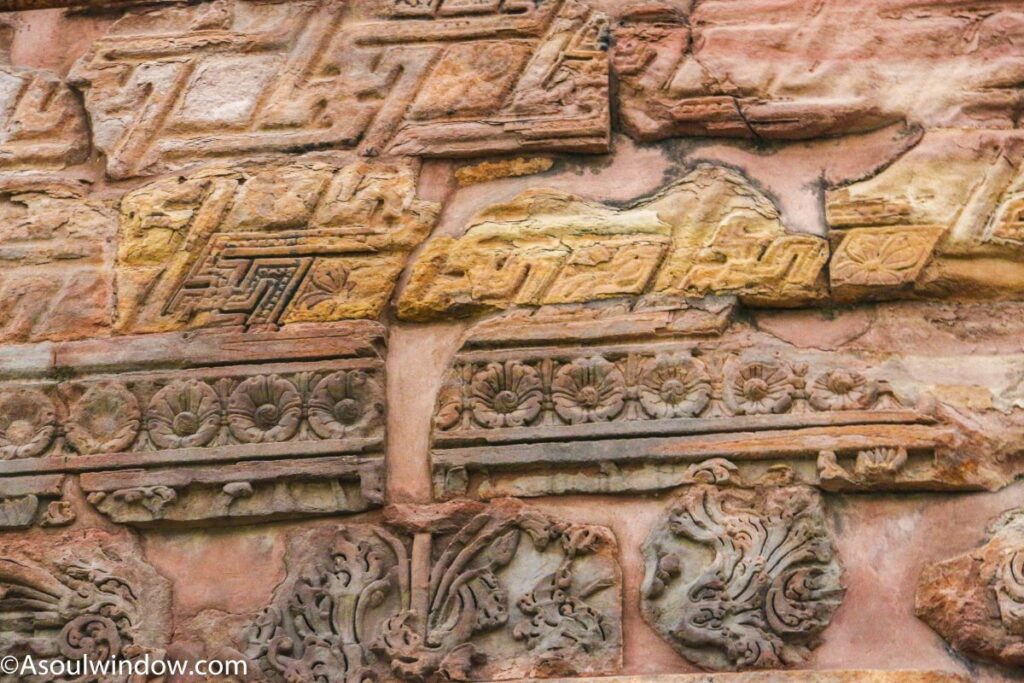
How to reach Sarnath in Varanasi
Sarnath, being located in a bustling city of North India is very easy to reach! Sarnath is located 23 min and 10.6 kilometers away from the main Varanasi city in the North East direction and can be accessed via NH 31.
By cab: You can book a cab from Varanasi main city or even other nearby cities such as Lucknow, Kanpur, Ayodhya, Jaunpur and Buddhist sites such as Kushinagar and Shravasti. They are the most expensive mode to reach Sarnath but also the most quick and convenient.
By air: Since Sarnath is an international destination, frequented by devout Buddhists of South East Asian nations such as Thailand, Myanmar, Sri Lanka, and South Asian countries like Sri Lanka, it has great air connectivity. Varanasi airport (Code: VNS), located in Babatpur, is the nearest airport from Sarnath. It is situated 30 kms away from Varanasi airport.
By train: Sarnath is easy to arrive at by Indian Railways. Varanasi Cantt is the closest railway junction from Sarnath and is located just 6 kilometers away. Sarnath has a tiny railway station of its own as well. However, not many trains make a halt here.
By bus: Buses from various parts of Varanasi as well as other nearby cities also ply to Sarnath. Apart from trains, it is the most cost-effective way of traveling to Sarnath.
Timings of Sarnath
Sarnath is open from sunrise to sunset during both winter and summer. Just before the sunset is the best time to be in Sarnath. During this golden hour, sun rays cast magic on the ruins of Sarnath, thereby enhancing its beauty manifolds.
Conclusion: Why visit Sarnath?
Sarnath is one of the most important Buddhist pilgrimage sites of India along with Shravasti and Kushinagar, all of which are located in Uttar Pradesh in North India. Buddhists from as far as Thailand, Cambodia, Laos and Sri Lanka visit this ancient land. Peppered with significant Buddhist sites such as the Dhamek Stupa, Chaukhandi stupa, Mulagandhakuti vihara, Ashokan Pillar and Deer Park, Sarnath is a must visit international destination of Varanasi.
You will get a good idea of the impressive Mauryan Empire, the life of Ashoka-the great and Bhagwan Gautam Buddha by paying a visit to Sarnath. This comprehensive guide answers all your queries on Sarnath. You will also see how Hindu and Buddhist culture that originated in India has influenced much of South East Asia and South Asia.
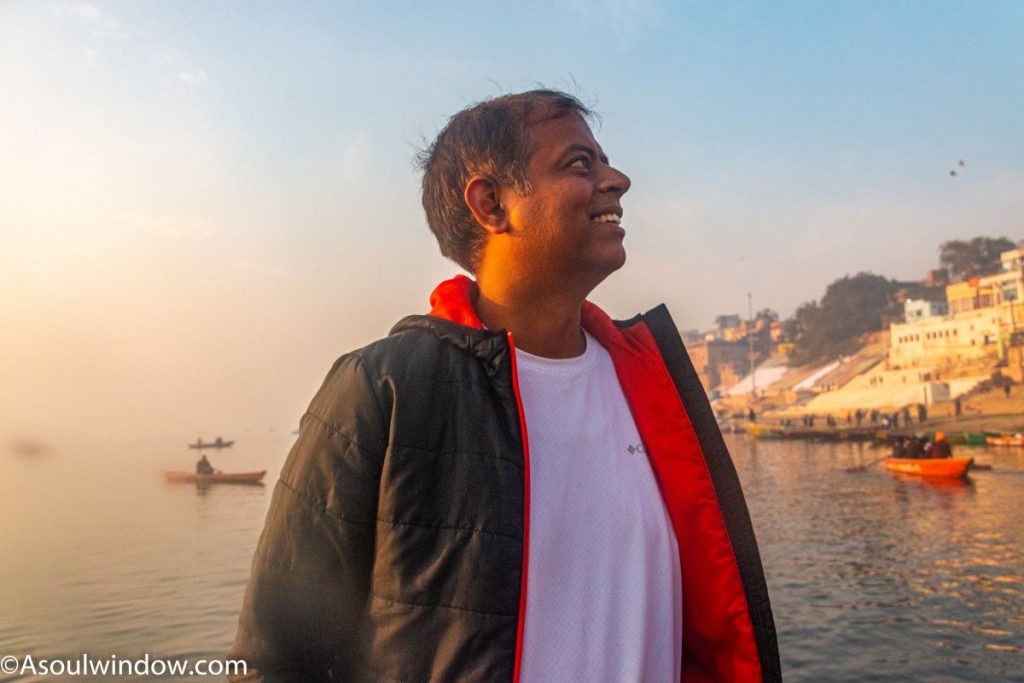
The view from my Soul Window takes me back thousands of years ago!
Pin this blog to save the blog and plan a trip later!
Related Blogs
If you want to read detailed travel guides on related topics, do check out below-mentioned comprehensive blogs. These places of Uttar Pradesh are related to each other in some way and you can use this information to plan a memorable trip in the ancient Varanasi and vibrant Uttar Pradesh.
Blogs on Varanasi
You must not miss the following informative travel guides on Varanasi or Banaras or Kashi.
About Dev Deepawali in Varanasi
Blogs on Buddhist Destinations
Below are some of the best Buddhist places I have visited and documented on my travel blog A Soul Window – the No. 1 travel blog of India.
Lumbini
Bodhgaya
Nalanda
Sanchi Stupa
Dambulla Caves
Blogs on Uttar Pradesh
Below are the mammoth travel blogs on other places to visit in Uttar Pradesh. Most of these places to see are major pilgrimages of Hindus.
Govardhan Parikrama Travelogue
Prem Sarovar of Barsana Travelogue
Shri Krishna Janmbhoomi Travelogue
Shri Radha Rani Mandir Travelogue
Vrindavan Travelogue
Shri Ram Janmbhoomi Mandir Travelogue
Travelogue on Bhavya Deepawali of Ayodhya
Bird photography in Dudhwa National Park
Dhangadhi near Nepal India border
Dudhwa National Park Travelogue
Lakh Bahosi Sanctuary Travelogue
Secret Kashmiri Pink tea of Lucknow
Top Travel Blogger from India
